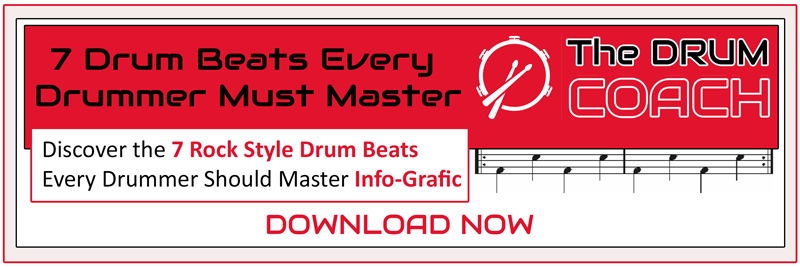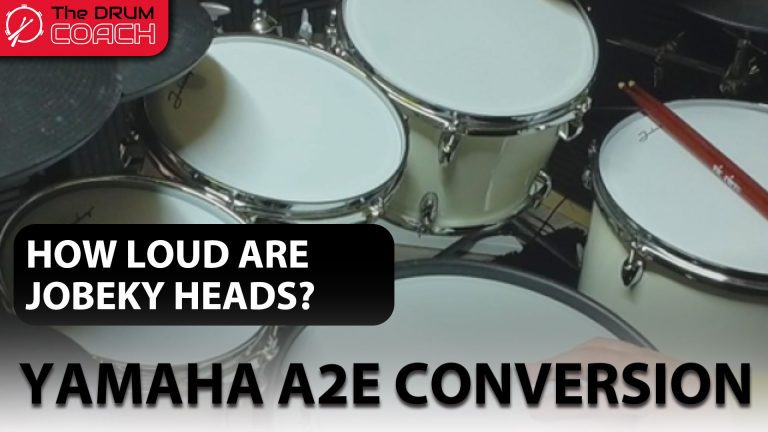![]()
In this article, we are going to teach you how to play a drum roll. There are four main types of drum roll that you need to know. These are the single stroke roll, double stroke roll, triple stroke roll, and buzz roll.
Each one of these rolls sounds different and can be used in a variety of situations.
Here, we will show you how to play each type of drum roll. We’ll go over the mechanics so you gain an understanding of how each is performed. So that you can start practicing and impress your friends and your family. As well as yourself, with your drum roll skills!
The secret to how to play a drum roll is to understand the sticking. A single-stroke roll is played Right Left Right Left, etc. A double-stroke roll is played Right Right Left Left etc. And a buzz roll is played by bouncing each stick on the head continuously. Whilst keeping the alternate Right Left Right Left sticking of the single-stroke roll going.
How To Play A Drum Roll – The Four Types of Drum Roll
The Single Stroke Roll
When starting out, the easiest way to learn how to play a drum roll is by starting with a single stroke roll. The Single Stroke Roll is one of the most basic and essential drumming techniques. It’s a simple concept – you play a single note with each hand, using a single stroke (or downbeat). You then play each of the single strokes alternatively. Right-hand, left-hand, right-hand, left-hand, (or R, L, R, L) and so on.
The Single Stroke Roll can be played slowly or quickly, depending on the tempo of the song. But in practice, you play it slowly until you can play it even at a slow tempo. You can then increase the tempo as you begin to build speed. But don’t rush this. Take your time and get comfortable with each tempo before speeding up.
When played slowly, it sounds smooth and even; when played quickly, it has a choppy, staccato sound. But then evens out as the speed increases. It sounds smooth as you develop. Single Stroke Rolls are used in all genres of music, from rock to jazz to classical.
The single-stroke roll is a versatile technique but must be practiced at slow tempos. And then built over time whilst remaining in a relaxed state. This is especially applicable to your arms hands and wrists.
The Double Stroke Roll
The next stop to learning how to play a drum roll is by mastering the double stroke, and double stroke roll. The double stroke roll is the most common type of drum roll. To play a double-stroke roll, the first stick (R) will hit the drum twice. After the initial stroke, the stick bounces a second time. it does this by releasing your grip on the stick to let it bounce after the initial stroke.
You then snap your fingers to grip the stick to stop the bouncing.
After you snap the stick around your fingers, you then repeat this process with the left hand.
You then repeat the above steps in quick succession to produce the roll.
To get a smooth sound, it is important to make sure that you control the bounce of the sticks. You may need to practice this a few times very slowly before you get it. But you will get the hang of it as you continue to practice slowly.
So the sticking is RR LL, RR LL, and so on.
The Buzz Roll
The buzz roll is a drum roll that’s played with each drumstick bouncing continuously. You bounce each stick in fast succession (but naturally) after the initial stroke. The initial stroke is played in a loose bouncing fashion. Meaning that you don’t lift the stick off of the head very high as you would a normal drum stroke. Instead, you let the stick bounce on the drum head.
 To play a buzz-type roll, you will need to hold the drumstick between your thumb and first two fingers. You then need to strike the drumhead with the drumstick. Let the stick just bounce until it stops. Then do the same with the other stick. The idea is then to control the bounces so you play (bounce) R L R L and so on. letting each stroke bounce before playing the next.
To play a buzz-type roll, you will need to hold the drumstick between your thumb and first two fingers. You then need to strike the drumhead with the drumstick. Let the stick just bounce until it stops. Then do the same with the other stick. The idea is then to control the bounces so you play (bounce) R L R L and so on. letting each stroke bounce before playing the next.
The key to playing a great-sounding buzz roll is to make sure that the drumstick bounces off of the drumhead. In a consistent and flowing manner. You may need to practice this a few times before you get it perfect. Once you have the hang of it, you will be able to play a great-sounding buzz roll.
The Triple Stroke Roll
The triple stroke roll is a drum roll that’s played using three strokes with each stick. This is called the Moeller technique.
The Moeller technique is a set of exercises designed to help drummers develop this skill. The key to the Moeller technique is to use the momentum of the stick to generate a smooth, even roll. Just as you controlled the bounce in the double-stroke roll technique. The exercises start with simple single strokes and gradually build up speed.
Each of the controlled bounces should create a smooth flowing roll. And again, slowly at first.
The Moeller technique can be difficult to master, but it’s well worth the effort.
To get a smooth sound, it is important to make sure each of the hands plays a single note. And then lets the stick bounce for 2 additional notes. These are much quieter bounces. This is of course controlled to sound like triplets.
You then play each hand alternatively. And eventually, produce a smooth flowing triple-stroke roll. But the main aim is to develop stick control, or rather bounce control. As the second two strokes are bounces with a hint of control applied to those bounces.
You may need to practice this a few times before you get the general flow going and then master it over time. As with all things drumming.
The triple-stroke roll is really an extension of the single-stroke roll. A single stroke roll uses single strikes of the hands using alternate sticking. Then the double stroke roll utilizes the same alternate motion, with the addition of a bounce. And then the triple stroke roll adds another bounced note. This then forms the triple stroke roll.
And it goes without saying that this roll, will need more attention than the others. Until you get used to the actual movement of each hand and the controlled bounces.
And so the sticking is thus: RRR LLL, RRR, LLL, etc.
Conclusion
Now that you know how to play a drum roll, specifically the four types of drum roll, you can start using them in your drumming. Experiment with different combinations of drum rolls to create your own unique sound. But pay special emphasis in the beginning to the single, double, and buzz roll. Then as you develop you should add the Moeller technique. But having said that, you can always practice the basic bounce technique over time and at slow tempos. There is no rush!
Have fun and enjoy yourself!
Thanks for reading! We hope this article was helpful in teaching you how to play a drum roll. If you have any questions, please feel free to leave a comment below and we will be happy to help you out.
The Drum Coach




